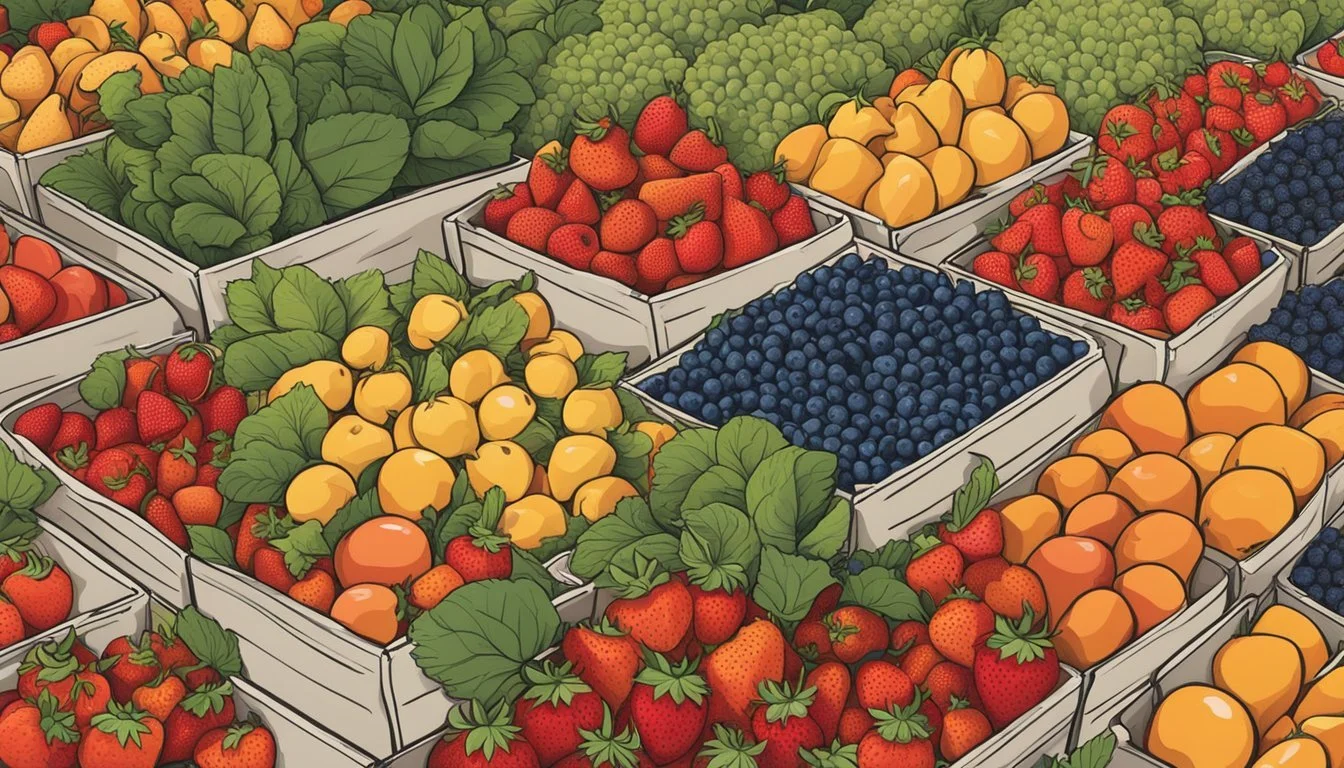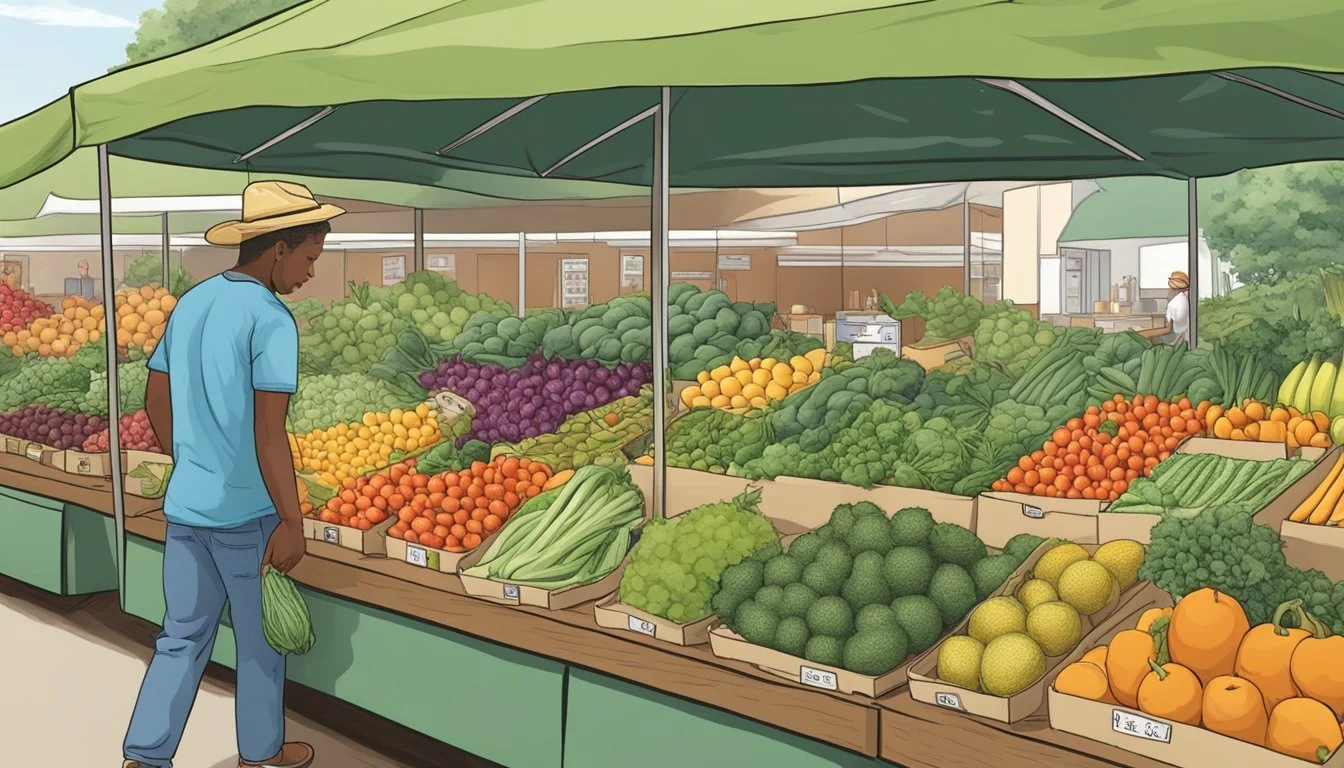North Carolina Seasonal Fruit & Vegetables in May
Your Fresh Produce Guide
This Article is Part of our North Carolina Seasonal Fruit & Veg Calendar
As spring blossoms in North Carolina, the favorable climate and fertile soil yield a bountiful array of fresh produce. May is a transitional month that sees the tail end of spring's bounty and the beginning of summer's harvest, making it a particularly rich period for seasonal fruits and vegetables. Food enthusiasts and health-conscious consumers alike gravitate towards local farmers' markets to indulge in the freshest picks. The seasonal offerings not only promise peak flavor and nutrition but also support the local economy and sustainable agricultural practices.
In this period, North Carolina's fields and orchards are especially generous with certain crops. Fresh asparagus (What wine goes well with asparagus?) spears are still tender and plentiful, perfect for a roasted dish or a vibrant salad. Strawberries, a beloved springtime favorite, reach their sweetest and juiciest state, inviting patrons to pick their own at local farms. The state also celebrates the arrival of succulent blueberries (how long do blueberries last?), which begin to make their appearance. Meanwhile, leafy greens like spinach and kale (What wine goes well with kale?) thrive in the mild temperatures, and herb gardens burst with fragrant basil, a versatile staple for many dishes. May is a month that offers an abundance of choices for those looking to savor fresh and locally grown produce.
Understanding the Seasons in North Carolina
In North Carolina, the interplay between the state's diverse climate and the rhythm of the seasons dictates the crop production calendar. Understanding this dynamic is crucial for both consumers and growers to optimize the availability of fresh produce.
The Role of Climate on Crop Production
North Carolina's climate varies from the mountainous west to the coastal east, influencing what and when crops can be grown. Spring arrives with a gentle warmth, allowing for an early start to the growing season. The transition into a hot and humid summer provides ideal conditions for a variety of fruits and vegetables. Fall ushers in cooler temperatures, extending the harvest period for many crops, while winter, though milder compared to northern states, still impacts the availability of fresh local produce.
Spring: Asparagus, broccoli, and leafy greens.
Summer: Tomatoes, cucumbers, and blueberries.
Fall: Apples, pumpkins, and kale.
Winter: Root vegetables and some greens that can be cold-hardy.
Overview of North Carolina's Seasonal Patterns
The state's seasonal patterns are a tapestry woven with the threads of spring's renewal, summer's bounty, fall's harvest, and winter's rest.
Growing Season: Typically begins in early spring and can last well into fall, providing an extended period for diverse crops.
Availability: Varies as some crops like blueberries peak in May and June and others like apples flourish in fall.
Season Key Produce Availability Spring Strawberries, leafy greens March to June Summer Peaches, tomatoes June to September Fall Apples, root vegetables September to December Winter Collards, sweet potatoes December to March
These cycles reflect how North Carolina farmers plan their crop rotations and how consumers can anticipate the freshest local produce during each season.
What's In Season: May Harvest
As the vibrant month of May arrives in North Carolina, it brings with it a bountiful selection of fresh produce. Shoppers and chefs alike can take advantage of the peak season for various fruits and vegetables, ensuring the freshest and most flavorful crops are at their disposal.
Fruits Available in May
Strawberries: They are a highlight of May, with their peak ripeness offering a sweet and juicy flavor.
Cherries (how long do cherries last?): Cherries begin to make their appearance in late spring, delivering a burst of sweet or tartness to the palate.
Vegetables to Enjoy in May
Cabbage: This versatile vegetable continues its season into May, perfect for slaws and salads.
Carrots: Available year-round, carrots harvested in May are especially sweet, making them great for both raw and cooked dishes.
Cilantro: Though available throughout the year, cilantro is especially fragrant and flavorful in the spring.
Chard: May sees the continuation of chard, offering earthy greens for sautéing or adding to soups.
Selecting and Storing Fresh Produce
In May, North Carolina offers an abundance of fresh fruits and vegetables. This section provides insights into how one can choose the freshest offerings and store them correctly to retain flavor and nutritional value.
Tips for Choosing the Freshest Fruits and Vegetables
When selecting fresh produce, one should look for fruits and vegetables that are firm to the touch and free from bruises or blemishes. Color is also a key indicator of freshness; vibrant, deep colors typically denote ripeness.
Fruits: Such as strawberries and blueberries should be plump and free of any mold or mushy spots.
Vegetables: Like asparagus should have bright green stalks and tightly closed tips.
When choosing leafy greens, they should look crisp and have a lively green hue without any yellowing. For example:
Lettuces: Choose heads that are firm and heavy for their size.
Kale: Select bunches with smaller, tender leaves.
Best Practices for Storing Seasonal Produce
Storing produce correctly is critical for prolonging freshness. Here are some specific guidelines:
Refrigeration: Certain fruits and vegetables such as asparagus and greens should be stored in the refrigerator to slow down the respiration rate and retain their crispness.
Use of Water: For some items like leafy greens, wrapping them in a damp paper towel before placing them in a bag can help maintain moisture. However, excessive moisture for fruits like strawberries can lead to quicker spoilage, so they should be kept dry until ready to use.
A general rule is to store fruits and vegetables separately as fruits can release ethylene gas, which can accelerate ripening in vegetables. Here's a brief storage table for reference:
Product Storage Method Strawberries In the fridge, in a single layer, uncovered Blueberries In the fridge, with ventilation Asparagus Upright in the fridge with ends in water Leafy Greens Damp paper towel, inside a fridge container Kale Loose in the crisper drawer of the fridge
It is also advisable to store produce in a way that allows for air circulation, which helps to prevent mold growth and keeps the product at its best for longer.
North Carolina's Farming Landscape
North Carolina's diverse climate and soil types allow for a rich variety of crops throughout the year. This section explores the staples of the Tar Heel State's agricultural productivity and the positive effects local farms have on the freshness and quality of produce available to consumers.
Key Crops and Their Growing Seasons
North Carolina’s farms grow an abundance of fruits and vegetables, with each crop having its specific growing season. In May, several crops reach their peak, offering consumers fresh local produce. Here is a brief overview highlighting some key crops harvested during this period:
Asparagus: March - April
Broccoli: April - May
Cabbage: May - December
Kale: available year-round but with a harvest peak in the spring and fall
Strawberries: April - June
Lettuce: April - October, with a peak in spring
Radishes: April - June
Peas: April - May
Matching crops to their ideal growing season ensures the best quality and flavor, as well as efficiency in local agricultural practices.
The Impact of Local Farms on Produce Quality
Local North Carolina farms have a significant impact on the quality of produce found both in the state’s grocery stores and markets. These farms bring forth crops like strawberries and asparagus in May, allowing consumers to enjoy them at their freshest, just after harvest.
Freshness: Produce from local farms reaches grocery stores and markets quickly, which means it retains more nutrients and better flavor.
Sustainability: Local farms often employ sustainable practices that enhance soil health and reduce the carbon footprint compared to produce shipped from distant locations.
The proximity of local farms to consumers helps maintain the produce's integrity from the field to the table.
May's Featured Fruits and Vegetables
May in North Carolina heralds the arrival of peak harvest times for a variety of fruits and vegetables. This month highlights the vibrant taste of fresh strawberries, the tender spears of asparagus, an abundance of leafy greens, and the beginnings of sweet corn availability.
Profile: North Carolina Strawberries
North Carolina strawberries begin their peak season in May. These berries are celebrated for their bright red color, sweet flavor, and juicy texture. Local farms offer pick-your-own experiences, ensuring consumers get the freshest strawberries straight from the field.
Spotlight on Asparagus
Asparagus, with its nutty and earthy flavor, steps into the spotlight during this time. Thriving in the cooler temperatures of late spring, these spears offer versatility in the kitchen, whether roasted, grilled, or steamed.
The Peak Season for Greens
May marks the peak for a variety of greens in North Carolina. The greens available include:
Spinach: Rich in iron and perfect for salads or sautéed dishes. (What Wine Pairs Best with Sautéed Dishes)
Kale: A nutrient powerhouse ideal for chips or smoothies.
Lettuce: Includes varieties like romaine, which is excellent for fresh, crisp salads.
These greens are pivotal for their nutritional value and freshness.
Sweet Corn: A Sought-After Summer Delight
Although typically associated with summer, sweet corn begins making its appearance in May. Cherished for its sweetness and tender kernels, it can be enjoyed boiled, grilled, or roasted.







